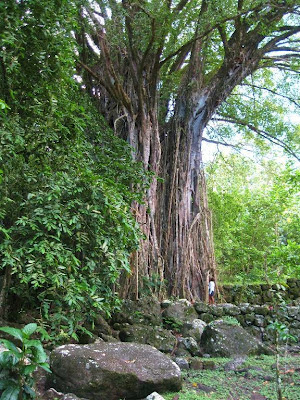When I think of palm fringed atolls and green coral strewn waters, I think relaxation - an escape from the stress of the work world. Strangely, we find our days here to be just as filled as we did back home, although we certainly have more say as to how we spend these hours. Take today for example - we did our weekly bucket laundry - wash, scrub, rinse, wring, rinse again, wring, rinse again, wring. We used water we had gathered last night during a rain squall by scooping water off our decks into buckets and containers. We then pegged the pillow cases, shirts, and smalls to our lifelines and ratlines - colourful pennants fluttering in the brisk southeasterly breeze. Today, doing the laundry was a pleasure. The amount was manageable, we split the work between us, and we were using lovely freshly gathered water - a gift from the sky. The sunny, windy, weather made short work of finishing things off - no fabric softener needed...
After laundry, our friends Mike and Karen on 'Chapter 2' gave us a ride to the nearby passes, where we drift-snorkeled twice through one pass and once through a smaller pass to the north. The current was snorting through the passes and we flew over trenches and hills of coral with an array of colourful fish drifting along below us. At one point two larger grey sharks swam vigorously toward us from the deeps, giving me a bit of a fright. They swam around our dinghy, probably trying to figure out what this strange multi-limbed creature was (we were hanging onto ropes tethered to the dinghy). We also saw a 6 foot lemon shark - identifiable by its colour and by having two dorsal fins.
On our way back to Ladybug we anchored off a coral reef that is the best I have seen so far. Yellows, beiges, purples, pinks, and browns in all manor of fantastic shapes. In places the formations looked like the cities imagined by science fiction writers and the fish were like shuttles drifting between towers on another world. In others the effect was like a carefully laid out botanical garden, with lovingly tended shrubs and bushes in a harmonious array of hues.
After our snorkel we had a bucket shower in the cockpit and cleaned the salt off our gear. Keeping salt out of the boat is a continuous concern, especially here where the high humidity would otherwise cause mildew inside. Next was lunch, after which I disassembled and cleaned our autopilot while Rani made hand-drawn postcards to send to our families. We rowed ashore in the late afternoon to explore the motu and walked a couple of miles, finding two neatly-maintained copra plantations and several workers' cottages. Some of these were made entirely of palm thatching over a pole frame and others were more substantial, with steel roofs. I climbed a coconut palm and brought down a few drinking nuts, which we cut up with a machete borrowed from one of the cottages. We hiked to the outer reef where we looked for shells on the coral sand beach and waded on the reef to check out some parrot fish that had been trapped in tide pools.
Back at the boat, we hoisted the dinghy on board in preparation for tomorrow's passage. Tonight we will probably read our books and maybe watch a movie on the computer. Once I post this blog, I will also download a weather file to help plan for the passage. So you see that our days are full. There seems to be little time to just lay back and relax - although neither of us is complaining.
We are currently anchored just south of the east pass of the Toau atoll. 15 56 S 145 53 W Tomorrow we sail for Anse Amyot - a small bay about 20 miles away at the northwest corner of this atoll.





























.jpg)